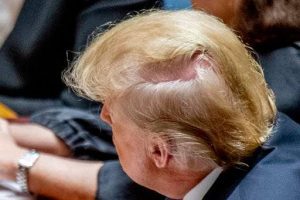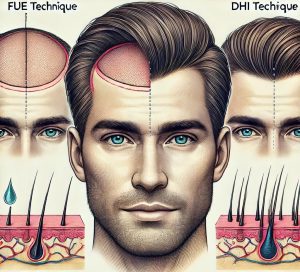Donald Trump, the 45th President of the United States, has always been a subject of intense media scrutiny, not just for his political career but also for his distinctive hairstyle. Over the years, speculation about Trump’s hair and whether he has undergone any surgical procedures to maintain its appearance has been rampant. Trump himself has consistently denied any allegations of plastic surgery or hair transplants. However, remarks made by his ex-wife, Ivana Trump, suggest a different story.

Donald Trump, 45th President of USA

Donald Trump at young age, with higher forehead and natural hair line
Ivana Trump’s Revelations
In 1990, during a deposition, Ivana Trump revealed that Donald had undergone a scalp reduction surgery in 1989. According to Ivana, Trump experienced significant pain and headaches post-surgery, leading to a fit of rage. Scalp reduction is a procedure designed to reduce balding by surgically removing bald areas and stretching the remaining scalp to cover the void. This technique, now considered outdated, often resulted in complications such as tight scalp, pressure headaches, and scarring.

Ivana Trump and Donald Trump

Possible marks after sculp reduction surgery
Despite the advancements in hair restoration, the topic of Trump’s hair continues to intrigue both the public and medical professionals. His steadfast denial of any surgical intervention and the counterclaims from his ex-wife keep the debate alive. Whether or not Trump had a scalp reduction surgery remains unconfirmed, but the peculiarities of his hair align with some of the known outcomes of such a procedure.

unnatural hair growth spotted
The Procedure and Its Drawbacks
Scalp reduction surgery was more common in the late 20th century before the advent of advanced hair restoration techniques. The process could indeed result in hair oriented in awkward directions, making it challenging for patients to style their hair naturally. Many who underwent this surgery resorted to comb-overs to mask scars and cover the irregular hair patterns. Trump’s hair, often described as atypical or unusual, has led many to speculate that he may have undergone this very procedure.

Sculp reduction surgery
Modern Hair Restoration Techniques
Today, scalp reduction is largely obsolete, replaced by less invasive and more effective hair restoration methods. Modern techniques such as Follicular Unit Extraction (FUE) and treatments involving Platelet-Rich Plasma (PRP) or exosome injections have revolutionized the field of hair restoration. These methods focus on rejuvenating and regenerating hair without the extensive scarring and complications associated with older procedures like scalp reduction.
Follicular Unit Extraction (FUE)
FUE involves the extraction of individual hair follicles from a donor site, typically the back of the head, and implanting them into the thinning or balding areas. This method ensures a more natural hair growth pattern and significantly reduces the risk of scarring.
Direct Hair Implantation (DHI)
Direct Hair Implantation (DHI) is an advanced technique similar to FUE but with a unique implantation process. Using the Choi Implanter Pen, hair follicles are extracted and directly implanted into the scalp without prior incisions. This allows precise control over the angle, depth, and direction of each hair, resulting in a natural growth pattern. DHI reduces follicle handling, improving survival rates and ensuring quicker recovery with minimal discomfort, making it ideal for those seeking precise and natural results.
Platelet-Rich Plasma (PRP) and Exosome Injections
PRP and exosome injections utilize growth factors to stimulate hair follicles and promote hair growth, offering non-surgical options for individuals seeking to combat hair loss. These treatments are minimally invasive and can be highly effective in rejuvenating hair growth.

FUE vs DHI Hair Transplant
The Ongoing Fascination
Despite the advancements in hair restoration, the topic of Trump’s hair continues to intrigue both the public and medical professionals. His steadfast denial of any surgical intervention and the counterclaims from his ex-wife keep the debate alive. Whether or not Trump had a scalp reduction surgery remains unconfirmed, but the peculiarities of his hair align with some of the known outcomes of such a procedure.
Conclusion
While Donald Trump maintains that he has never undergone plastic surgery or hair transplants, the testimony from Ivana Trump and the characteristics of his hair suggest otherwise. The outdated technique of scalp reduction, which Trump allegedly had, is no longer in use due to its complications and the development of more advanced, effective methods. As the fascination with Trump’s hair endures, it highlights the significant progress in hair restoration techniques and the ongoing public interest in the personal lives of prominent figures.
Modern hair restoration methods, such as FUE and PRP, offer natural and effective solutions for hair loss, free from the complications of older techniques. Whether you are a public figure or an everyday individual, achieving a fuller head of hair is now more accessible and advanced than ever before.
Disclaimer: The content on this blog is intended for general informational purposes only. It is not a substitute for professional medical advice, diagnosis, or treatment. Always consult qualified healthcare providers for personalized advice. Information regarding plastic surgery, dental treatment, hair transplant, and other medical procedures is educational and not a guarantee of results. We do not assume liability for actions taken based on blog content. Medical knowledge evolves; verify information and consult professionals. External links do not imply endorsement. By using this blog, you agree to these terms.





